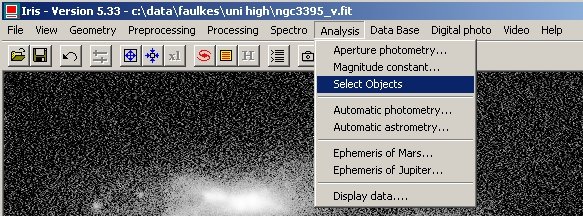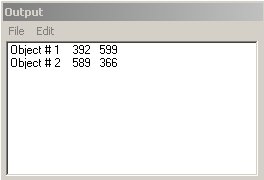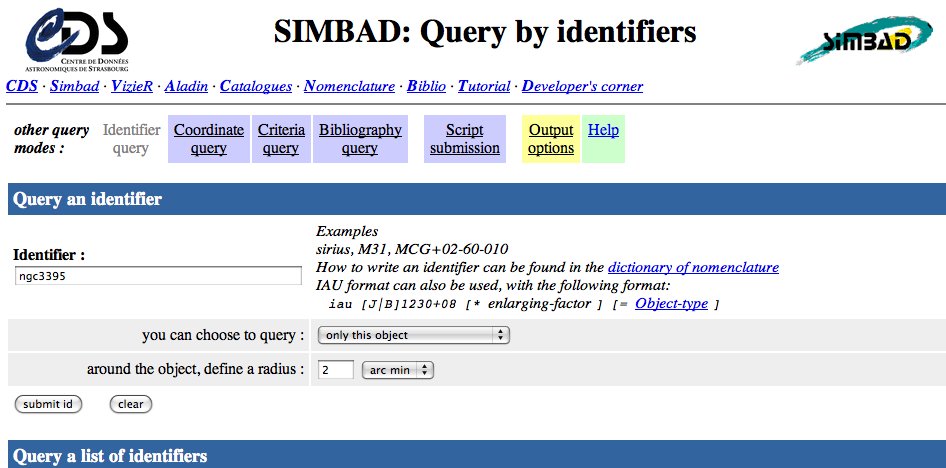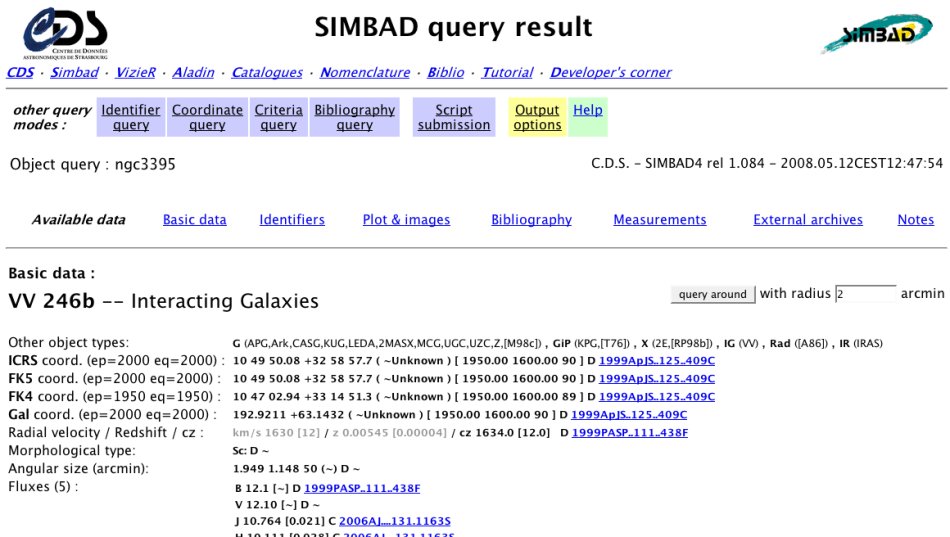Space to Grow
Interacting Galaxies
Measuring the sizes of the Galaxies
This section can be quite mathematical so you might want to check before assigning this exercise to your students. A way around this is to determine some of this for yourself in advance and give students some of these numbers.
- Open the image.
Open IRIS and Load the V image file for the interacting galaxies you wish to study. Adjust the threshold levels until you think you can discern the edges of the galaxies, or click on View » Modified Equalization. NGC 3395 is used for this example.
- Mark the edges of the galaxies.
Students must decide where they think the edge of each galaxies lies. There may be significant differences depending on the threshold or display settings each student has decided to use and this can be a topic for discussion in class: "How do you decide where the galaxy finishes?"
Select Analysis » Select Objects…

Figure 7: Select ObjectsThe cursor will change shape and an Output window will pop up on the screen. Click at one edge of one of the galaxies and the x,y-coordinates will appear in the Output window. Click at the other edge of the same galaxy and these x,y-coordinates will also appear in the Output window.

Figure 8: Coordinates - Determine the size of the galaxy in pixels.
Using the Pythagorean theorem, these x,y positions can be used to determine the apparent diameter of the galaxy in pixels.
Size in pixels = sqrt [(392 – 589)2 + (599 – 366)2]
= 305.1 pixels - Determine the size of the galaxy in arcseconds.
Each pixel of the Faulkes Telescope images corresponds to a size of 0.27837 arcseconds. This is set by the properties of the CCD camera and the focal length of the telescope.
Size in arcseconds = 0.27837 arsec/pixel * 305.1 pixels = 84.9 arcseconds
- Find the distance to the galaxy in Megaparsecs (Mpc).
Open the SIMBAD Query Database:
http://simbad.u-strasbg.fr/simbad/sim-fid
Type the name of the object into the Identifier section and select Submit ID.

Figure 9: SIMBAD query.This will return a page of basic data on that object.

Figure 10: SIMBAD query results.
Look up the cz value for the object under the Radial velocity/redshift/cz section. In this case it is 1634.0 km/s.
The distance to the galaxy in Mpc can now be found using the following equation:
D (Mpc) = cz/H0
where H0 is the Hubble constant which we will set at 70 km/s/Mpc.
- Determine the size of the galaxy in Mpc using the small-angle formula.
The appendix, taken from http://cosmos.phy.tufts.edu/~zirbel/laboratories/AstrometryPreLab.pdf, explains the derivation of the small-angle formula. You may also refer to Part 1, Step 6 of the Age of a Planetary Nebula teaching module for further explanation.
The calculation for the above galaxy would be:
Size in Mpc = [(Dist to gal in Mpc) * (gal size in arcseconds)]/ 206265 arcseconds
For NGC 3395:
Distance to galaxy = 23.3 Mpc (calculated in Step 5.)
Size in arcseconds = 84.9 arcseconds (measured in Step 4.)
Size in Mpc = (23.3 * 84.9) / 206265 ≈ 0.0096 Mpc = 9,600 pc. - Convert parsecs into light years.
1 parsec ≈ 3.26 light years
Size of NGC 3395 in light years ≈ 31,000 light years.You may wish to compare this with the size of the Milky Way, which is 100,000 light years across.
Make a colour image using IRIS
Return to the main page for this module
Exercitationem
Visi ut aliquid ex
Ut enim ad minima veniam, quis nostrum exercitationem ullam corporis suscipit laboriosam, nisi ut aliquid ex ea commodi consequatur.
Visi ut aliquid ex
Quis autem vel eum iure reprehenderit qui in ea voluptate velit esse quam nihil molestiae consequatur, vel illum qui dolorem eum fugiat quo voluptas nulla pariatu
Et harum quidem rerum facilis est et expedita distinctio.
